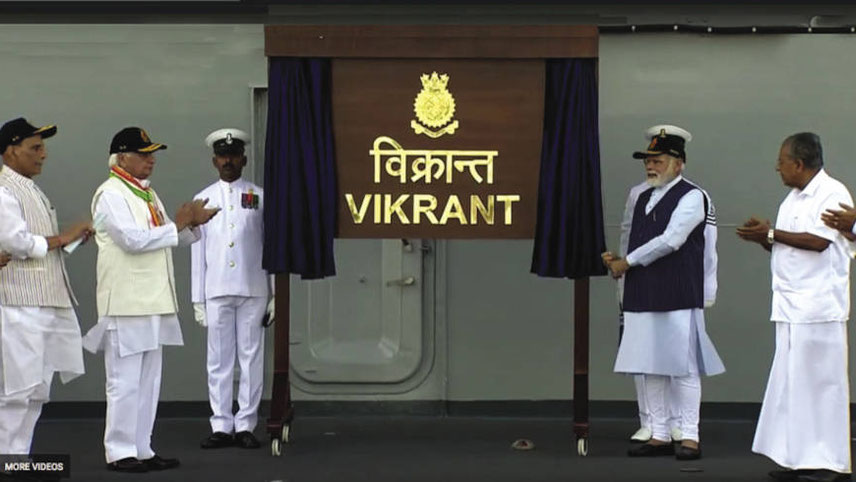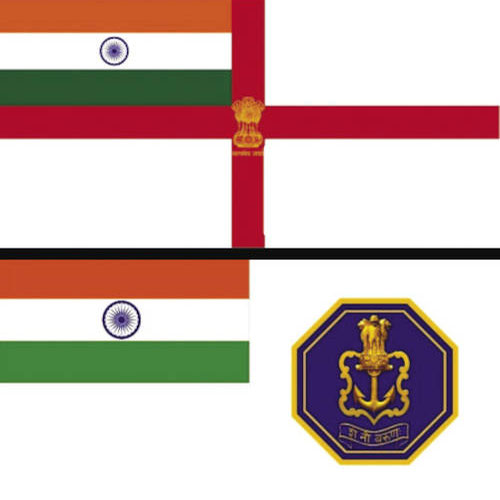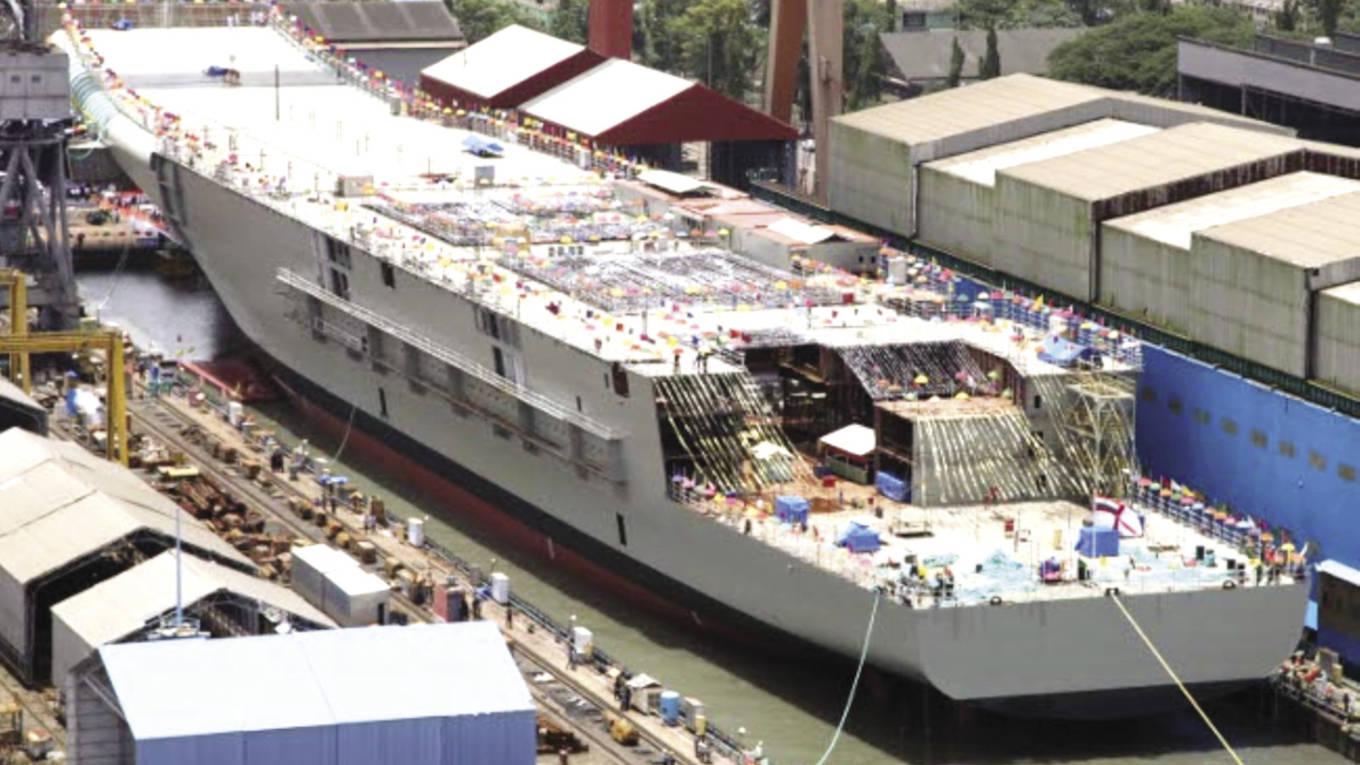-

Landmark occasion: Prime Minister Modi commissions INS Vikrant
Designed with a high degree of automation for machinery operations, ship navigation and survivability, the 262.5m carrier, with a beam of 62m and height of 59m, including the superstructure, has a maximum designed speed of 28kts (52 kmph), cruising speed of 18kts (33.3kmph), and endurance of 7,500nm (13,890 km). It has 14 decks, including five in the superstructure, and over 2,300 compartments, designed for a crew of around 1,700, including specialised cabins for woman officers.
With the aircraft carrier, Indian yards will have indigenously built almost all types of naval platforms, including strategic projects like the nuclear missile-tracking Ocean Surveillance Ship (OSS) and the Technology Demonstrator Vessel (TDV) for the Defence R&D Organisation (DRDO).
However, as with most major developments in the present political climate, Vikrant’s commissioning too became politicised. Modi showcased what he termed the country’s growing prowess of indigenous manufacturing as ‘a major milestone in the atmanirbhar Bharat abhiyaan’ (Self-reliant India Campaign) that is credited to him.
“This (Vikrant’s commissioning) is an important part of the huge transformative change taking place in India under the leadership of the prime minister,” stated Defence Minister Rajnath Singh. Senior government and naval functionaries too maintained that the commissioning represented ‘a true reflection of the honourable Prime Minister’s ‘Make in India’ and ‘Atmanirbhar Bharat’ initiatives’. On an earlier occasion, Singh had indicated that “the steps taken by the government will continue to boost efforts at self-reliance and we will soon build ships not just for India, but for the entire world”.
India has been building warships for the past half a century, but defence officials today are duty-bound to credit present as well as past indigenous developments as realisations of the Prime Minister’s vision. The first major warships built in India had been the six 6,670-tonne Nilgiri class frigates, updated variants of the Royal Navy’s Leander class Type 121, that were constructed between 1972 and 1981 by the country’s premier defence shipyard, Mumbai’s Mazagon Dock Limited (MDL), in association with Yarrow Shipbuilders.
INS Godavari became India’s first indigenously designed and built warship, when its keel was laid at MDL in 1978. Commissioned five years later, this 3,600-tonne guided-missile frigate was showcased around the world as a symbol of what the Defence ministry had then described as India’s growing military might and self-reliance.
Appropriating all credit
Even India’s submarines are claimed to have been built under the benevolence of Prime Minister Modi, though the first submarines to be built in the country were the final two of four HDW (now part of thyssenkrupp Marine Systems) 1,660-tonne Shishumar class Type 1500 diesel-electric submarines. The first two were constructed at the HDW yard in Kiel, Germany, while the balance were made by MDL under technology transfer from HDW, the keel of INS Shalki having been laid in 1984 and the boat commissioned in 1992, while INS Shankul was laid in 1989 and joined service in 1994. The recently-retired Indian Navy chief Admiral Karambir Singh had also hailed the building of INS Vikrant as a shining example of the Prime Minister’s ‘Make in India Initiative’.
In reality, as with most military projects in India, Vikrant too has had a tortuous chronology that delayed its commissioning by over seven years, after the Modi government came to power in 2014. The project approval for construction of an IAC had been accorded by the Atal Behari Vajpayee government’s Cabinet Committee on Security in 1999, with revisions in 2002 and 2014. The keel was laid in 2009 and the hull floated out of its dry dock in 2011.
-
INS Godavari became India’s first indigenously designed and built warship, when its keel was laid at MDL in 1978. Commissioned five years later, this 3,600-tonne guided-missile frigate was showcased around the world as a symbol of what the Defence ministry had then described as India’s growing military might and self-reliance.
The Indian Navy website records the vessel’s launch, and christening, in August 2013 by Elizabeth Antony, the wife of then Defence Minister A.K. Antony of the Congress-ruled government, ‘Vikrant’ meaning ‘mighty’ or ‘courageous’ in Sanskrit. The Navy’s 2013 report mentions, “At the launch, marking the end of Phase I of the project, the imposing ramp of the (then) 37,500-tonne Short Take-off but Assisted Recovery (STOBAR) carrier boasted the indigenous design and build capabilities of the country.”
It adds: “The ship has attained its designed length of about 260m and is almost at its maximum breadth of 60m. The main landing strip is ready. Over 80 per cent of the structure, containing about 2,300 compartments, has been fabricated, over 75 per cent has been erected, all the major machinery, such as the two LM2500 gas turbines, developing a total power of 80MW, the diesel alternators, capable of producing about 24MW, and the main gear-box have been fitted.” The General Electric LM2500 gas turbine is a simple-cycle, two-shaft, high-performance engine trusted by 33 navies worldwide.
Describing the occasion as a ‘momentous’ one, Antony said, “It is indeed a proud moment for the country to witness our efforts at achieving self-reliance in the field of warship design and construction, as only a very few advanced countries in the world possess the capability to design and build aircraft carriers.”
In its 2016 construction audit report, the Comptroller and Auditor General (CAG) noted, “There is continuing disagreement over project timelines between the Indian Navy and CSL, with realistic dates for delivery yet to be worked out.” It added, “Neither the Ministry of Defence (MoD) nor the shipyard could assess the physical state of construction of the ship as the Ministry failed to incorporate essential formats for progress reporting in the contracts.”
Despite its commissioning, INS Vikrant is not fully operational, as it sails without an Aviation Facility Complex (AFC) that will be supplied by Russia’s Nevskoe Design Bureau (NDB) by the end of next year to support a carrier air wing comprising MiG-29K fighter aircraft, Ka-31 airborne early warning helicopters, MH-60R multirole helicopters, as well as the indigenous Dhruv Advanced Light Helicopters.
Indian Navy Vice Chief, Vice Admiral S.N. Ghormade, told reporters recently: “We designed the Vikrant for operating the MiG-29K, but we would ultimately deploy the indigenous TEDBF (Twin-Engine Deck-Based Fighter) for which we are working with DRDO. For the interim, we are looking at Rafale and F/A-18 aircraft, and trials have been carried out.” Evaluating, testing and selecting the aircraft, and then training our naval aviators for them, will be a lengthy process.
‘Indian Maritime Security Strategy Document’ of 2016 propounds a force structure focused on the development of three Carrier Battle Groups (CBGs), each centred on an aircraft carrier with multi-mission escort and support ships with integral anti-air, antisurface and anti-submarine warfare capabilities. This entails the development of an operational capability of two Carrier Task Forces (CTFs), each comprising one or more CBGs and other specialist forces, to meet the growing requirements of protecting India’s maritime interests.
However, only two carriers have been envisaged for the present, with INS Vikrant joining the fleet alongside the Navy’s 44,750-tonne INS Vikramaditya (ex-Russian Admiral Gorshkov), which too is a STOBAR carrier and which joined service in 2013. INS Vikramaditya will serve with the Western Naval Command (WNC) and INS Vikrant, the Eastern Naval Command (ENC).
China leaps ahead
The MoD has declined approval for the proposed IAC 2 that it deems exorbitant for its estimated cost of around $10 billion. At 65,000-tonne, IAC 2 was envisaged as India’s largest carrier, with Catapult Assisted Take-Off (CATOBAR) capability. Indeed, an Indian Navy delegation had visited the UK in 2019 to consult with BAE Systems on the design and construction processes of the 65,000-tonne HMS Queen Elizabeth that it had built as the largest and most powerful vessel for the Royal Navy.
-

Indian Navy’s new ensign (below) was released at the commissioning, replacing the old one (above)
The Parliamentary Standing Committee on Defence, however, made out a case for a third carrier last December when it deemed it an “unavoidable requirement to meet any eventualities”, considering the “long coastline and hostile adversaries on both sides of the Indian peninsula”. A committee report submitted to the Lok Sabha in March lists the IAC-2 and Multi-Role Carrier-Borne Fighters (MRCBFs) among other items under “details of acquisition planned by the Indian Navy for the year 2022-23”.
India was the first country in Asia to operate an aircraft carrier when it acquired the 19,500-tonne INS Vikrant (former HMS Hercules, and the forebear of the present Vikrant) from Britain in 1961. This was followed by the procurement of the 28,700-tonne INS Viraat (former HMS Hermes), also from Britain, in 1987. INS Vikrant was decommissioned in 1997, and INS Viraat, in 2017.
Both became the world’s oldest operational carriers, the hull of Vikrant having been laid down in 1943 and launched in 1945 and of Viraat, in 1944, but not launched until 1953. Vikrant also played a historic role when it spearheaded the navy’s stupendous expedition in the Bay of Bengal during the 1971 Indo-Pakistan war.
The Indian Navy is up against a growing maritime threat from China, whose military modernisation has become the top focus of US defence planning and budgeting. Its People’s Liberation Army Navy (PLAN) has emerging as numerically the largest in the world, its 360 battle force ships outnumbering the US Navy’s 297. India has 130 ships and submarines, with 39 more vessels under construction.
China has besides been fortifying the Pakistan Navy as well, building four technologically advanced Type 054 A/P frigates, two of which have already been delivered, and helping Pakistan build and acquire eight Hangor class submarines. Four of the submarines will be built in Pakistan, and the remaining four in China, all of them expected to be delivered by 2028.
While China too has two operational carriers at present -- Soviet-designed Kuznetsov-class carrier Liaoning bought in 1998 and commissioned in 2012, and Shandong, based on Liaoning and both displacing 60,000 to 70,000 tonnes full load – its third carrier, the ‘most advanced’ 80,000-tonne Fujian, will be its first aircraft carrier with a fully indigenous design. Shandong took only two years between launch, in April 2017, and commissioning, in December 2019.
Fujian was launched on 17 June and may also join service within two years. PLAN’s fourth aircraft carrier is likely to be a CVN (Carrier, Aircraft, Nuclear), and a recent report of the Washington-based think tank, Center for Strategic and Budgetary Assessments, says PLAN possesses the resources to field up to five aircraft carriers and 10 nuclear ballistic missile submarines by 2030.




































